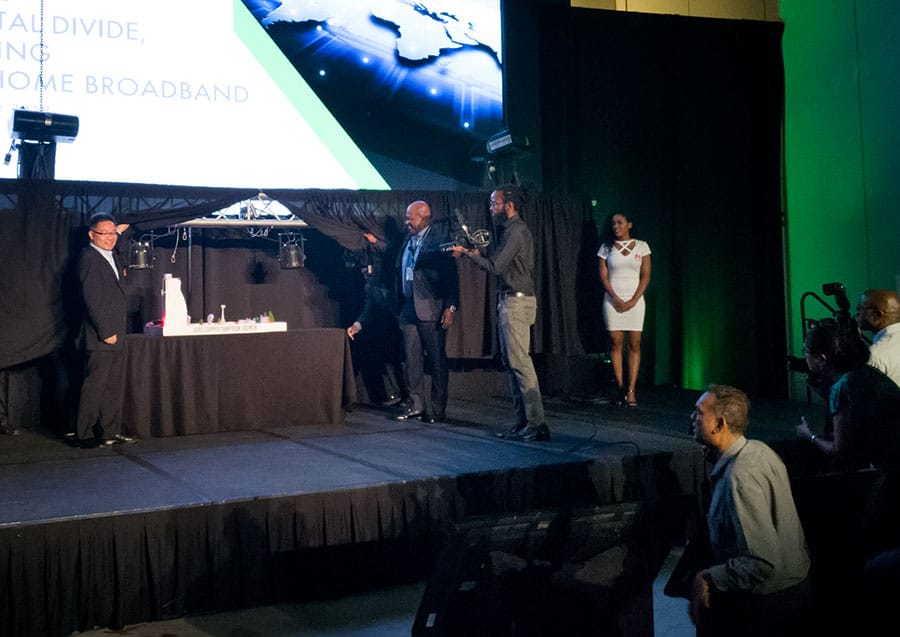
Above: Huawei’s Yang Weijun, President, LATAM Carrier Business and TSTT’s Dr Ronald Walcott reveal a model titled “Zero Copper Campaign Launch” at the Hyatt Regency. Photo by Mark Lyndersay.
BitDepth#1165 for September 04, 2018
TSTT announced its Zero Copper campaign on Friday last week. The company slipped the announcement into a very technical conference on its adoption of WTTx, a next generation product for improving its coverage of Trinidad and Tobago.
To symbolise its commitment to this initiative, which targets the abolition of all customer connections using copper cabling within 18 months, it dropped an artless model of a futuristic city from the ceiling of a conference room at the Hyatt Regency with agonising slowness and deliberation.
Then there was fussing behind a black curtain for long minutes, then with lots of flashing lights, a ceremonial button was pushed and there was applause, some of it reluctant.
It was an almost perfect theatrical summary of how the company has struggled to shed itself of the legacy network of the past and of copper connections in particular.
My first interview with a TSTT executive about the need to replace copper was in March 2006, when Cedric Cole, then the company’s VP for Customer Care, explained the need to abandon its 1980’s infrastructure and move to fiber optic cabling.
That $600 million, turn of the century project was part of a requirement for the Telecommunication’s Authority’s new competitive environment, cutting its hard connection to its customer’s homes. Customers were fitted with the now ubiquitous Network Interface Box, a gray blob on your wall that allows any service to connect to customers. The copper lines stuck around.
TSTT wants to bring you another box, this one powered by WTTx, a pervasive wireless technology that it’s been quietly implementing since 2014.
Depending on network coverage, a customer will get an indoor WTTx box, an object roughly the size of a small toaster, which acts as a fixed wireless connection to the company’s networks. Customers in remote locations will get an external box that extends reception range.
The company was frank about the challenges it faces over the next few months to make this happen.
Copper is accessible to 95 percent of the population, and a surprisingly high number of customers simply don’t want to give up their existing phones. It works, they are satisfied and see no need to switch.
Since 2016, the company has been struggling to get customers off 2G, offering cheap smartphones and discounts to customers still using the system. Finally, the company announced in August that it would end the service. In response to a query about that matter, TSTT responded: “We have basically turned off our GSM/2G network.”
“We embarked on our Mobile Long Term Strategy (MLTS) which had three phases. First, we turned down GSM and moved all our customers to UMTS. Second, we increased our UMTS 3G capacity and third; we launched LTE in 1900MHz.”
“We were awaiting the 700MHz spectrum from TATT but that has not yet been released. We have very limited customers that are still on GSM or 2G.”
Hassel Bacchus, TSTT’s Chief Network Officer admitted that “This has been a long journey.”
That journey has been complicated by factors beyond customer reluctance. TSTT had a challenge with addresses for their customers, with a database that had an error rate of 40 percent.
“We had to go find the customers and geocode them for ourselves,” Bacchus said.
Then they are going to go to the rest, door by door, and persuade them to switch from their copper connection to the new little box, the Customer Premises Equipment or CPE.
That will give them what the company describes as “like for like,” an equivalent user experience to their copper connection.
That will include retaining their existing phone number, though their calls will become IP packets rather than pulses on an ageing wired network. Working in the company’s favour is the easy deployment, which consists of getting the Huawei designed box, plugging it in and connecting a phone to it.
Implicit in all the company’s recent announcements is a commitment to reversing decades of institutional lethargy and an acknowlegement of the technology cruft that’s piled up in that time.
Making it happen this time will demand an unremitting effort of will that has tended to elude TSTT at crunch times.


